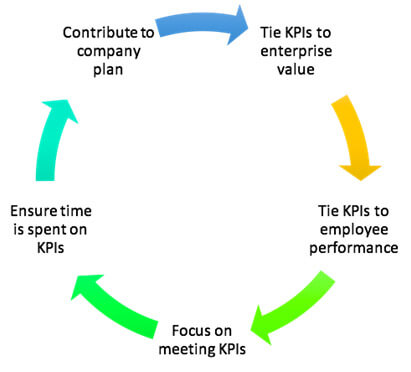How to Flip Cost Center to Value Driver
 Let’s be real: not every department is directly delivering new revenue. Depending on which department you operate — especially as you get “farther back from the front lines” — it may feel very hard to show the value you deliver to the organization. You may feel like your team’s budget is a target for cost-cutting measures, especially when the CFO is creating pressure to meet this year’s EBITDA goals. Maybe such measures are called for, but it’s also quite possible that your team and its spend are not tuned to deliver optimal value back to the organization.
Let’s be real: not every department is directly delivering new revenue. Depending on which department you operate — especially as you get “farther back from the front lines” — it may feel very hard to show the value you deliver to the organization. You may feel like your team’s budget is a target for cost-cutting measures, especially when the CFO is creating pressure to meet this year’s EBITDA goals. Maybe such measures are called for, but it’s also quite possible that your team and its spend are not tuned to deliver optimal value back to the organization.
There are five steps you can take to retune your team to do just that.
Step One: Make sure your KPIs tie directly and clearly to drivers of enterprise value.
There are many possible drivers of value for your company, but I tend to focus in on four key pillars of value: revenue growth, customer retention, recurring revenue, and profitability. The prioritization of these – and their respective goals – will vary from company to company based on several factors; but they are commonly among the most important components of enterprise value.
So, your first step is to create KPIs for your department that, when met, demonstrably support one or more of these four components (here’s a quick primer on what Key Performance Indicators are). This means you need to know what the company goals are for each of these four pillars. If you don’t, your CFO can give you this information (and if she doesn’t know, then she should appreciate the prompt for her to set those goals.)
As with “SMART” goals, make sure that each KPI standard is specific, measurable, and realistic. Ask yourself (and others) the obvious question: If we achieve this KPI standard, will we have materially contributed to one or more drivers of enterprise value? Only choose KPI standards where the answer is Yes.
Step Two: Ensure your department KPIs are tied 100% to every department employee’s performance management
One thing that people crave is clarity in their job: what do I need to do in order to be considered successful? Often: what can I do to get ahead?
In my view, the best way a leader can answer those questions AND deliver value to the company is to very clearly tie their definition of success to the definition of success of the team. Team success was defined in Step One, so now you cascade those KPI standards straight to the team members themselves, in ways that are utterly clear and utterly achievable. Establishing this accountability gives each team member the ownership they want and need to be successful. Historically these specific goals might be called “MBOs” (short for a style called Management By Objective), but the nomenclature or method isn’t all that important. What’s important is that you and the employee have complete mutual clarity on what they’re responsible for, and how it ties to the departmental KPIs.
Step Three: Ruthlessly focus on meeting the KPIs
It’s relatively easy to establish standards. Achieving them is the hard part. The key is to maintain a focus on them: first by communicating clearly that these KPIs are absolutely the focus of the team (and why), and second by tracking progress with regular checkpoints on a quarterly, monthly, and even weekly basis. At your checkpoints, one approach to consider is borrowing from agile development and identifying barriers (“blockers”) to progress on the KPIs, and then removing or mitigating the blockers.
The checkpoints should serve as the core cadence, or heartbeat, of your team. Every time, everyone will know that the team will be holding itself accountable for the progress against those standards, and every team member knows that her/his own performance is measured by their contributions thereto. The public display of progress (or lack of progress) serves as a motivator between checkpoints.
Step Four: Ensure the vast majority of your team’s time is spent specifically in support of meeting the KPIs
Unless your team is comprised solely of superheroes – or perhaps you set standards that were easy to meet – you will inevitably find that the team is slipping on some of them. To maximize focus and truly lock down the criticality of meeting the KPI standards, you should ensure that the team is actually spending its precious time on these value-driving performance standards, rather than getting distracted with the shiny objects, waste, and noise that so often infects our daily work schedules.
Track the team’s time — including your own — in a way that is easy to summarize and report on, clearly showing the amount of time spent on KPI-related work versus other work. Use these reports in the checkpoints to make changes as necessary to get back to focus. In this way, spending time on the KPIs becomes a kind of “meta-KPI”.
Moreover, you may identify other insights:
- If you find that the KPIs are all being met while only a minority of the team’s time is working on KPIs, then you may need to add more value-driving work to the team (if that’s even possible) or consider the reality that you need to reorganize or staff down.
- Conversely, if you find that the KPIs are not being met while nearly all of the team’s time is spent working on them, you may need to staff up or upgrade your team.
Step 5: Proactively contribute to the development or modification of the company’s KPIs/plan
The first four steps should transform your team into a true driver of value to the organization. To take it to the next level, show initiative and find a way to participate in the development or modification of the company’s KPIs/plan for the next year or reporting period. Use the lessons you learned in your own processes to inform your thinking and suggestions. Focus on behaviors that drive enterprise value: revenue growth, customer retention, recurring revenue, and profitability. This is your opportunity to be a part of the “strategic think” that will guide the company to greater value creation in the coming year.
Conclusion
Taking these steps most definitely requires work and takes time. This is an effort that will likely take weeks or months, and is ultimately an ongoing, iterative process.
However, if you do these things, think about what it would actually mean: you will be able to provably tie the output of your department into a generator of fundamentally important value to your company. Moreover, you will have demonstrated that your team is not only contributing in terms of its own function, but you’re also strategically contributing to the company’s continuous improvement related to enterprise value.
Let’s Get Started. Book a Demo Today.
Journyx helps you track time for projects, payroll, and more. Learn how Journyx can help you use time to your advantage in your business.



